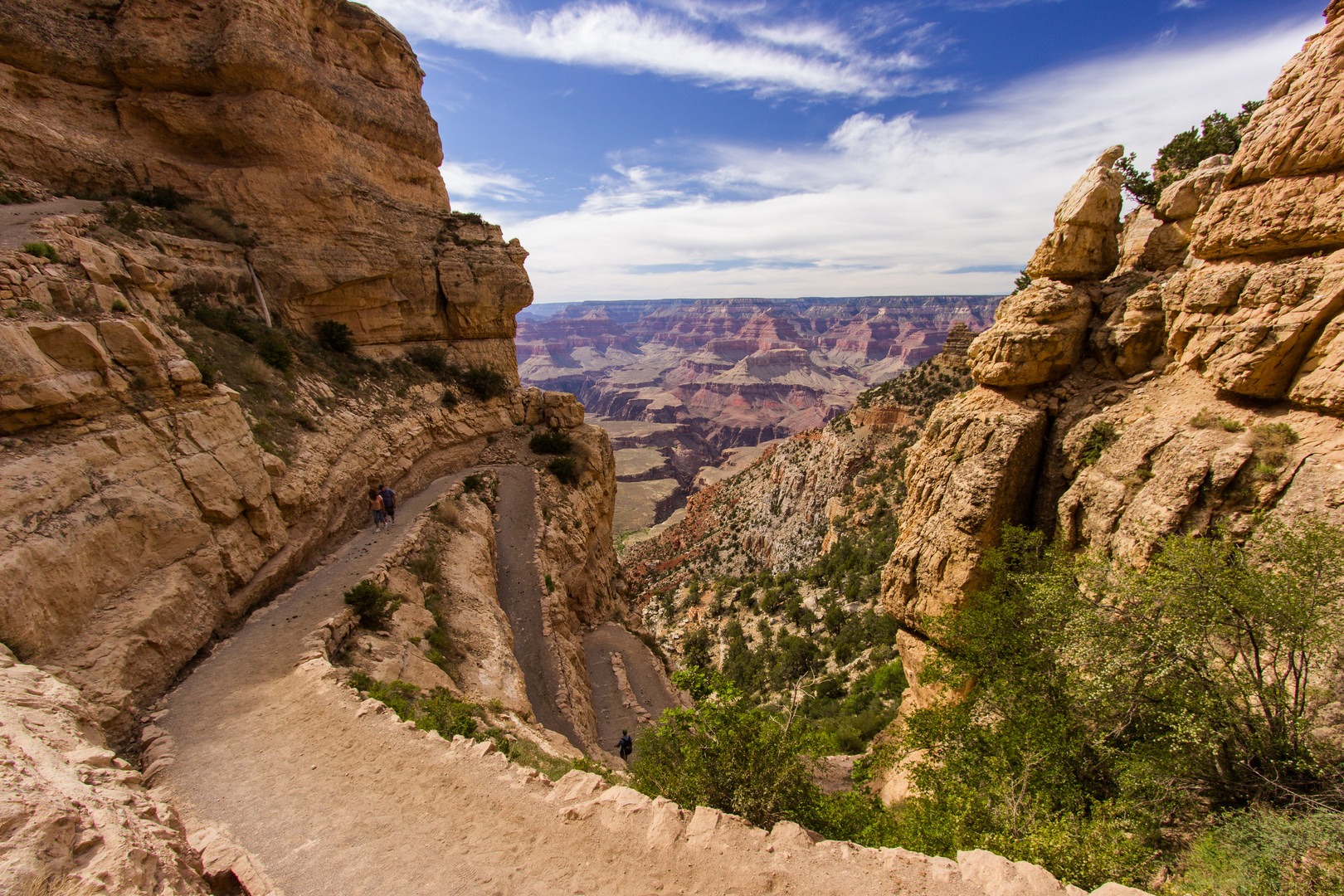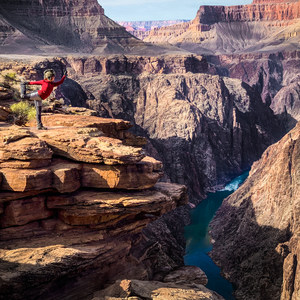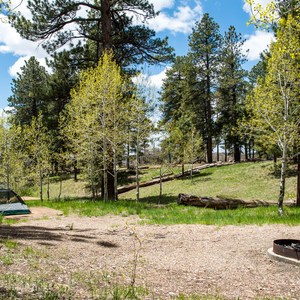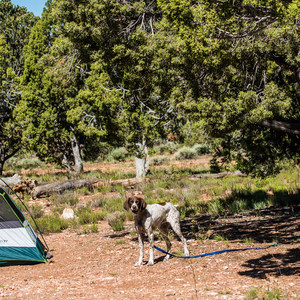You are here
There are certain strands of our national fabric, such as the Lincoln Memorial or a soaring bald eagle, that are truly inspirational in their majesty. The Grand Canyon is among these, and so much more. It's difficult to articulate the feeling of first laying eyes on this cavernous abyss high on the Colorado Plateau.
The adventure described here covers the iconic south rim to river trails, South Kaibab and Bright Angel, but there are many more options for exploring this outdoor wonderland. A little research and investigation reveals a plethora of lesser-known routes in, out, through, and around the Grand Canyon. This geological marvel, the foundation of which began some 2 billion years ago, also possesses rich mining and tourism history that is well worth exploring.
Note that both trails also function as routes for mules carrying passengers and supplies to and from the canyon rim. When you encounter a mule train, yield the right of way, stand to the inside of the trail, and follow the instructions from the mule guide. Mules played an invaluable role in the history of the canyon, and they remain important today. Despite what the growing number of trail runners in the canyon might tell you, these trails were originally built with mules and for mules.
South Kaibab Trail Descent
The South Kaibab Trail is the fastest route to the river, descending 4,780 feet in 7 miles. It is also frequently billed as the most scenic of the south rim trails, making it an ideal descent route. This trail is the descent and ascent route for Phantom Ranch pack mules and the ascent route for passenger mules, making it quite likely you will encounter mules on the trail. The trail departs near Yaki Point at an elevation of 7,260 feet and immediately descends through a series of tight switchbacks known as The Chimney. Grade soon levels out and traverses northward below the towering rim wall of Yaki Point. The first milestone on the trail is Ooh Ahh point at 6,660 feet and 0.9 miles from the trailhead, offering a sample of the spectacular panoramas yet to come. The trail proceeds to Cedar Ridge, where you can find vault toilets, before passing below the east wall of O'Neill Butte and descending to Skeleton Point at 5,220 feet and 3 miles from the trailhead. Skeleton Point, which offers the first glimpse of the Colorado River nearly 3,000 feet below, is a common day-trip destination, and the farthest one recommended by the park.
A series of steep switchbacks begin immediately after Skeleton Point, offering the most extreme exposure found on this route. The trail descends over 1,200 feet in 1.4 miles to reach The Tipoff, where there is a vault toilet and an emergency phone. Note that just prior to The Tipoff you'll find the east-west junction with the Tonto Trail, and beyond The Tipoff the trail leads behind the Tonto Plateau and descends into the inner gorge of the canyon following the route of the earlier Cable Trail that was built it 1907. Approximately 0.5 miles from The Tipoff is the amazing Big Pan overlook that is also known as Panorama Point. At 3,600 feet, this point provides stunning views of the inner canyon and Colorado River.
Departing Big Pan, another series of switchbacks descends 1,120 feet in 1.5 miles and passes the junction with the river trail before arriving at the southern side of the Kaibab Suspension Bridge. The scale of the mighty Colorado River is remarkable up close, and it's amazing to look up at the canyon walls and contemplate how the river's width has gone virtually unchanged over time: the outward growth of the canyon has occurred as an effect of the river cutting downward. The Bright Angel Campground is another 0.5 miles following a level grade along the Colorado River and Bright Angel Creek.
Overnight options in this area of the canyon floor are limited to the Bright Angel Campground and the historic Phantom Ranch.
Bright Angel Trail Ascent
The climb out of the canyon on the Bright Angel Trail ascends 4,380 feet in 9.5 miles. In comparison to the South Kaibab route, Bright Angel offers a more gradual climb, more shade, and most importantly, several potable water spigots. This trail is the daily descent route for passenger mules, so once again, encounters on the trail are likely.
The early goings of the Bright Angel route are relatively relaxing compared to the latter portion. Shortly after departing the Bright Angel Campground the trail crosses to the south side of the Colorado River via the Silver Bridge. Besides serving as a footbridge, the Silver Bridge also provides a support structure for the transcanyon water pipeline that pumps water from the North Rim to the South Rim. After crossing the Colorado River, the sand trail traverses west along the south bank following a relatively level grade to the River Resthouse. The trail then turns south into the Pipe Creek drainage, leaving the rushing Colorado River behind. For 3.2 miles the trail leads over varied terrain that includes an abandoned mine and a switchbacks known as the Devil's Corkscrew before reaching Indian Garden Campground, where you'll find toilets and water. Groves of cottonwood trees and an eastbound junction with the Tonto Trail signal an impending arrival at the oasis of Indian Garden.
At the campground, a side trip to Plateau Point presents itself. At this point in the journey out of the canyon, the additional 3-mile round-trip hike over of relatively flat ground seems inconsequential. In another hour or two, midway through the upper Bright Angel switchback circuit, one may revisit the soundness of such logic, but the views from Plateau Point are undoubtedly spectacular.
The next landmark after Indian Garden campground is Three-mile Resthouse, named for its distance from the rim. Water is seasonally available here. The final 3 miles is of trail is a steady grade of switchbacks that climbs the remaining 2,100 feet to the rim. Although steeply graded, this section of the trail also has quite a bit of shade that provides some relief from the sun in warmer months but can generate additional difficulty in winter due to lingering ice. The halfway-point in both elevation change and distance is the Mile-and-a-half Resthouse at 5,729 feet and 7.9 miles from Bright Angel Campground). This final push will terminate at the Bright Angel Trailhead on the western side of Grand Canyon Village, very near Kolb Studio. Outdoor Project users should be sure to visit the studio perched on the shear canyon cliffs, and relish the history of these kindred spirits and pioneers of outdoor adventure photography.
Climate and Logistics
The varying conditions between the rim and river can not be overemphasized. In the summer, the canyon floor is sweltering, even if rim conditions are less extreme. During this adventure it snowed on the rim while the weather at the floor was exceedingly comfortable, with daytime temperatures around 70 degrees. Visitors should prepare for drastic temperature differentials throughout the trip. There are no potable water sources on the South Kaibab Trail, and some of the water on the Bright Angel Trail is only available seasonally. There is also no parking allowed at the trailhead, but bus service is offered by the park.
Logistics + Planning
Current Weather: Powered by Dark Sky






























Comments
Sign In and share them.